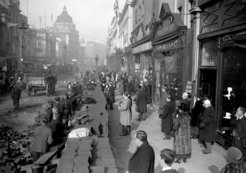A Political and Cultural History of the Minute's Silence
Karsten Lichau

The minute’s silence is a political ceremony that was established as a commemoration practice in remembrance of the soldiers killed in the First World War and that, during the following years, became an important part of national remembrance culture in many western European countries.
By analysing the connections between micro-historical practices and their complex social, political and cultural contexts, the research project explores the different resonance of the minute’s silence in the political cultures of Great Britain, France and the German Reich between 1919 and 1935.
Focusing on the acoustic and emotional staging of a collective political body, the various practices that serve the evocation of political unity will be explored from the perspective of a history of sound and emotions: the different sounds composing the acoustic framework of the ceremony (music, bells, cannons, guns or flares), as well as the practices of silence themselves, aim to articulate an emotional community. Yet, this emotional community is in no way homogenous: the spectrum of elicited emotions – conjured up by official calls, or described in journal articles and personal accounts – encompasses very different feelings (grief, pride, veneration, gratefulness, joy, but also anger or hate) and varying degrees of emotional intensity (reaching from deeply moved over more superficial participation up to indifference and overt distance). In addition, the emotional and acoustic staging is susceptible to deliberate or unintended disturbances, which may occasionally cause the entire ceremony to fail.
Approaching the minute’s silence from a history of knowledge and cultural history perspective brings out the ceremony’s ambivalent character, which allows for both religious and secular interpretations: as a promise of (at least) momentary "re-enchantment" of the secular world through silence, standstill and a "sacred" aura, but also as a precise synchronisation of secular bodies in public space, rendered possible only by exact and rational technologies of measuring and announcing linear time, hence a central means of modern disenchantment. In this, the minute’s silence relates to the unstable and dynamic "formations of the secular" (Talal Asad).
